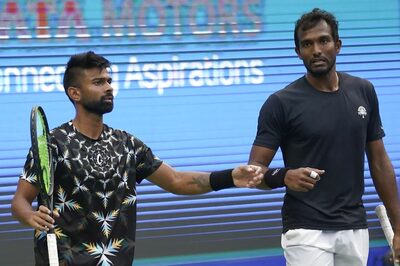
views
When schools were shut down seventeen months ago, no one could have predicted how long classes would remain suspended. Online teaching was perceived as a substitute for teaching in a physical space. Soon enough, the limitations of online learning became evident, but there was apparently no option, even during the spells when the virus was relatively less active in many regions. And now when classes have resumed, reports indicate that teaching has started from ‘where we left it’ online. In other words, the syllabus remains the sole organizer of time and interaction between teachers and students. Not just the only shaper of pedagogic effort, the syllabus remains a compulsorily linear basis for the teacher’s choice of what needs to happen.
Teachers can’t be blamed for what is happening. Their place in the system is low and they are never free to take decisions on their own. In fact, they are never consulted when a decision is made. This is true both when policies are formulated by the government and when principals and school managers take decisions about their school. The use of digital technology has further diminished the status of teachers. They were already a meek, compliant workforce; they have now become mute spectators of indefensible choices. Many of them are also frightened of becoming redundant because of increased use of technology.
ALSO READ | As Schools Begin to Unlock, Teachers Will be Frontline Warriors—But They Must be Trained
How realistic is this fear? Certainly it is not altogether imaginary. Owners and managers of school chains do often claim that smart classes alter and often reduce the teacher’s responsibilities. Use of devices based on artificial intelligence comes with similar claims. Who is to say that these claims are exaggerated? There is so much distrust in the ethos—both of private and government schools—that the idea of downsizing staff and transferring salary expenditure to purchase of new machines does not appear a neurotic fantasy.
Perhaps these are distant fears. The more immediate prospect is that of dealing with live classrooms after a gap of nearly two years during which children got used to being at home. Their behaviour and responses to routine school life may not all be easy to face in the coming months. On top will be the urgency to prepare them for exams and achievement surveys. Teachers’ hands will be full, and their hearts will have to suspend any expression of concern for children’s emotional health.
And even though schools have been reopened, the online option continues. What that means for teachers is just not discussed. The exhaustion caused by excessive online work can only get worse when teachers are compelled to keep both modes alive simultaneously. Handling a post-COVID classroom is likely to present unknown issues, arising from the long closure; maintaining the online contact with children whose parents will not allow them to go to school will be a formidable burden. Should the teacher pay attention to the children sitting in front of her, or should she rather focus on the screen of her smartphone? It’s hard to imagine how she can do both at once; and how she can adjust her voice, her speech, so that both groups can comprehend.
The fact that primary schools are the last to reopen speaks volumes about our system and the perspective that guides it. Little children are the most vulnerable category among the young as far as institutional support is concerned. To make sure that no child leaves the school before completing eight years of education was a major milestone in the growth of our collective understanding and the policies that govern education. This milestone was marked by the passage of the Right to Education Act through Parliament in 2009. Dilution of its norms was already happening and resistance to its implementation was unrelenting, but COVID has given a harder blow to the right. A whole new reality is consolidating around us.
Several civil society groups and individuals concerned with children have raised the question of ‘learning loss’. In some cases, the term was used to put pressure on the state to reopen schools. We can’t judge if it is this pressure that has led to the reopening of government schools in some states. Even in these states, private schools have responded to the pressure. They apparently feel that their online pedagogy is adequately protecting children from ‘learning loss’. When they eventually reopen, they might judge the situation better.
As far as government schools are concerned, they are carrying on routine teaching. Reports indicate that in some states, government schools are already preparing children to face a national achievement survey to be carried out in November. Outrageous as this may appear, the idea is apparently associated with the belief that online learning has successfully prevented any learning loss. If an achievement survey can prove this, critics of online teaching will be silenced along with those who think that the prolonged school closure has led to losses in children’s learning.
ALSO READ | Do Children Have To Be Vaccinated To Get Back To School?
The real problem with the ‘learning loss’ argument is that it ignores children’s broader developmental needs by focusing exclusively on ‘learning’ as the outcome of teaching. Advances in the theoretical study of learning had established that children’s minds develop in complex ways. The impact of the child’s environment is a major factor in how the mind’s capacities are expressed and shaped.
Despite this general wisdom that psychology has generated, a major change has occurred over the recent years in the way learning is discussed in many countries, including ours. A narrow view of learning and how it occurs has returned into popular currency. This view gels with the prevailing realities of the system at many levels. One is the level of parental anxieties. They are all about the child’s preparedness for competitive tests and the syllabus they are based on. The industry that offers to prepare the child for these tests constitutes another level at which the narrower view of learning operates.
The syllabus-centric view of learning makes it virtually impossible for schools to look at the alternatives they might pursue in order to mitigate the effects of school deprival on children of different ages. One alternative is to allocate generous space and regular time to the arts. Music and theatre have great value for reorganizing young minds after a long period of disturbance in life’s pattern. Visual arts have a similar role, especially at the primary school level. Reorganizing the time-table of the remaining months of this truncated session in a manner that permits aesthetic experience to take precedence over the regular subjects would go a long way in improving the ethos and children’s re-adjustment to school life.
However, it is rather unlikely that the pressure on schools to catch up with the ‘lost learning’ will allow them to consider any serious engagement with the arts despite their recognized healing potential.
Krishna Kumar, an educationist, was director of NCERT from 2004 to 2010. The views expressed in this article are those of the author and do not represent the stand of this publication.
Read all the Latest News , Breaking News and IPL 2022 Live Updates here.




















Comments
0 comment